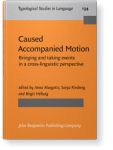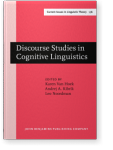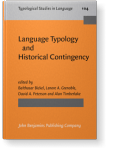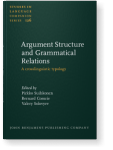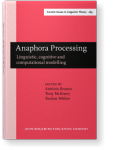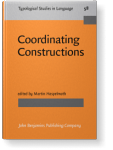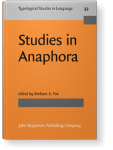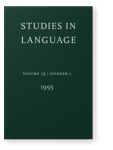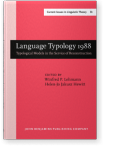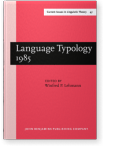Andrej A. Kibrik
List of John Benjamins publications for which Andrej A. Kibrik plays a role.
Book series
Title
Discourse Studies in Cognitive Linguistics: Selected papers from the 5th International Cognitive Linguistics Conference, Amsterdam, July 1997
Edited by Karen Van Hoek, Andrej A. Kibrik and Leo Noordman
[Current Issues in Linguistic Theory, 176] 1999. vi, 187 pp.
Subjects Cognition and language | Discourse studies | Pragmatics
Articles
2020 Chapter 1. Russian spoken discourse: Local structure and prosody In Search of Basic Units of Spoken Language: A corpus-driven approach, Izre'el, Shlomo, Heliana Mello, Alessandro Panunzi and Tommaso Raso (eds.), pp. 35–76 | Chapter
We previously developed an approach to spoken Russian monologic discourse, and are now extending that, looking primarily at interactional multi-party discourse, contextualizing speech phenomena as multichannel (multimodal) communication. The evidence analyzed is the Russian Pear Chats and Stories… read more
2020 Chapter 6. The Moscow approach to local discourse structure: An application to English In Search of Basic Units of Spoken Language: A corpus-driven approach, Izre'el, Shlomo, Heliana Mello, Alessandro Panunzi and Tommaso Raso (eds.), pp. 367–382 | Chapter
This chapter is an exploratory study in which we apply an approach to local discourse structure and prosody, developed for spoken Russian, to English talk. A key conceptual element of our approach is the notion of elementary discourse unit (EDU). EDUs are identified on the basis of prosodic… read more
2013 Discourse semantics and the form of the verb predicate in Karachay-Balkar: A corpus-based and experimental study Language Typology and Historical Contingency: In honor of Johanna Nichols, Bickel, Balthasar, Lenore A. Grenoble, David A. Peterson and Alan Timberlake (eds.), pp. 3–46 | Article
Karachay-Balkar, a Turkic language of the Northern Caucasus, uses both finite and nonfinite verb forms to report narrative events. How do language users choose between these options when producing discourse? I propose a discourse-semantic distinction between plain temporal sequence and a sequence… read more
2012 What’s in the head of head-marking languages? Argument Structure and Grammatical Relations: A crosslinguistic typology, Suihkonen, Pirkko, Bernard Comrie and Valery Solovyev (eds.), pp. 211–240 | Article
Marking of clause participants’ semantic roles is an important concern in human languages. Dependent-marking languages mark semantic roles by means of nominal case affixes. This article explores the expression of roles in head-marking languages, using Athabaskan languages of North America as the… read more
2005 Modelling Referential Choice in Discourse: A Cognitive Calculative Approach and a Neutral Network Approach Anaphora Processing: Linguistic, cognitive and computational modelling, Branco, António, Tony McEnery and Ruslan Mitkov (eds.), pp. 163 ff. | Article
2004 18. Coordination in Upper Kuskokwim Athabaskan Coordinating Constructions, Haspelmath, Martin (ed.), pp. 537–553 | Chapter
1.Introduction
2. NP conjunction
2.1 The main pattern: ʔił-conjunction
2.2 Other functions of ʔił
2.3 No other formal markers of NP conjunction
3. Clause conjunction
3.1 The main pattern: ts’eʔ-conjunction
3.2 Other functions of ts’eʔ
3.3 Other formal devices of… read more
2002 16. “Anomalies” of cross-reference marking: The Alutor case Morphology 2000: Selected papers from the 9th Morphology Meeting, Vienna, 24–28 February 2000, Bendjaballah, Sabrina, Wolfgang U. Dressler, Oskar E. Pfeiffer and Maria D. Voeikova (eds.), pp. 199–212 | Chapter
1999 Reference and Working Memory: Cognitive inferences from discourse observations Discourse Studies in Cognitive Linguistics: Selected papers from the 5th International Cognitive Linguistics Conference, Amsterdam, July 1997, Van Hoek, Karen, Andrej A. Kibrik and Leo Noordman (eds.), pp. 29 ff. | Article
1996 Anaphora in Russian Narrative Prose: A Cognitive Calculative Account Studies in Anaphora, Fox, Barbara A. (ed.), pp. 255 ff. | Article
1995 Review of Payne (1992): Pragmatics of word order flexibility Studies in Language 19:1, pp. 223–237 | Review
1993 Transitivity increase in Athabaskan languages Causatives and Transitivity, Comrie, Bernard and Maria Polinsky (eds.), pp. 47 ff. | Article
1991 Maintenance of Reference in Sentence and Discourse Language Typology 1988: Typological Models in the Service of Reconstruction, Lehmann, Winfred P. and Helen-Jo Jakusz Hewitt (eds.), pp. 57 ff. | Article
1986 The meaning-form correspondence in grammatical description Language Typology 1985: Papers from the Linguistic Typology Symposium, Moscow, 9–13 Dec. 1985, Lehmann, Winfred P. (ed.), pp. 163 ff. | Article
